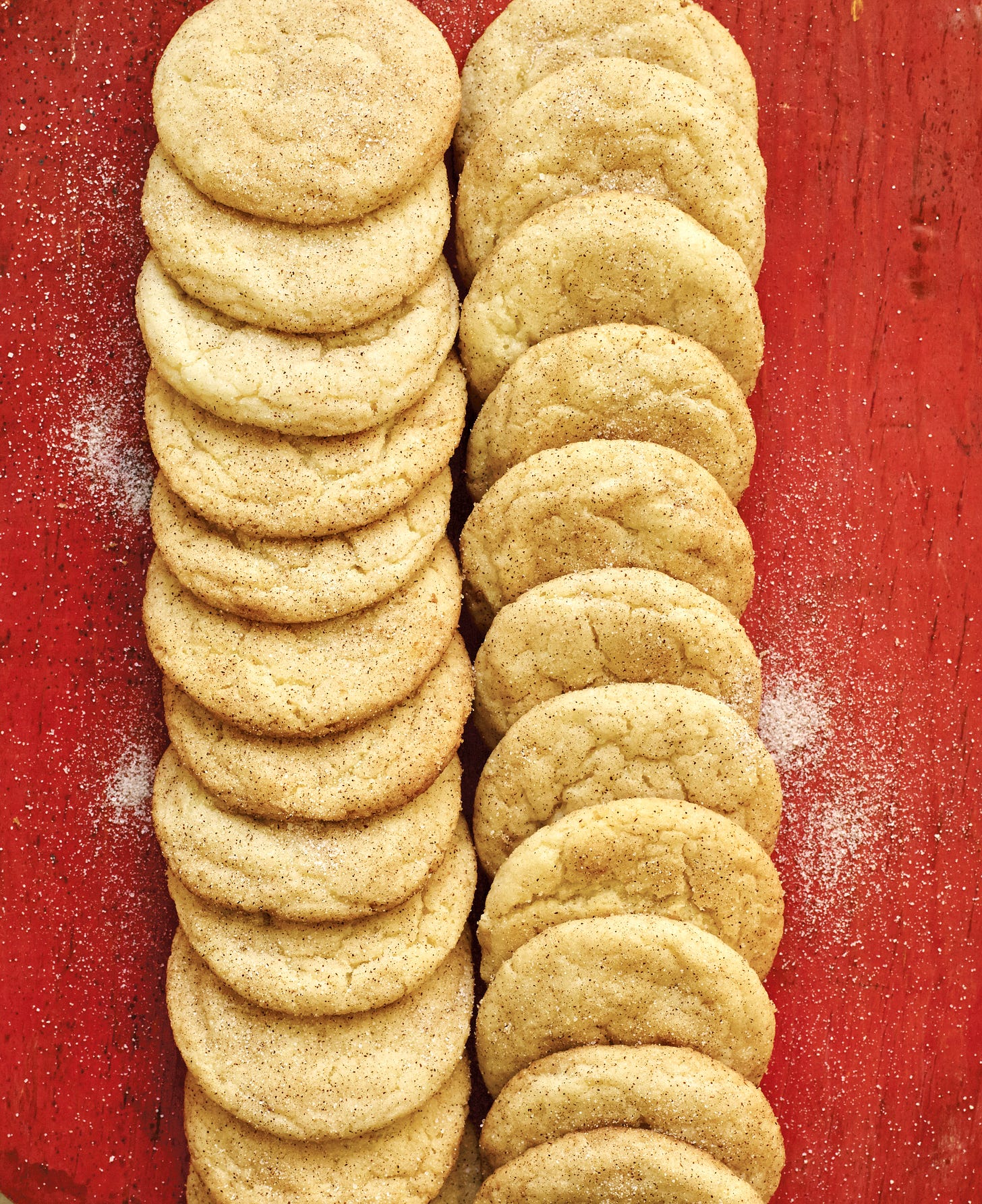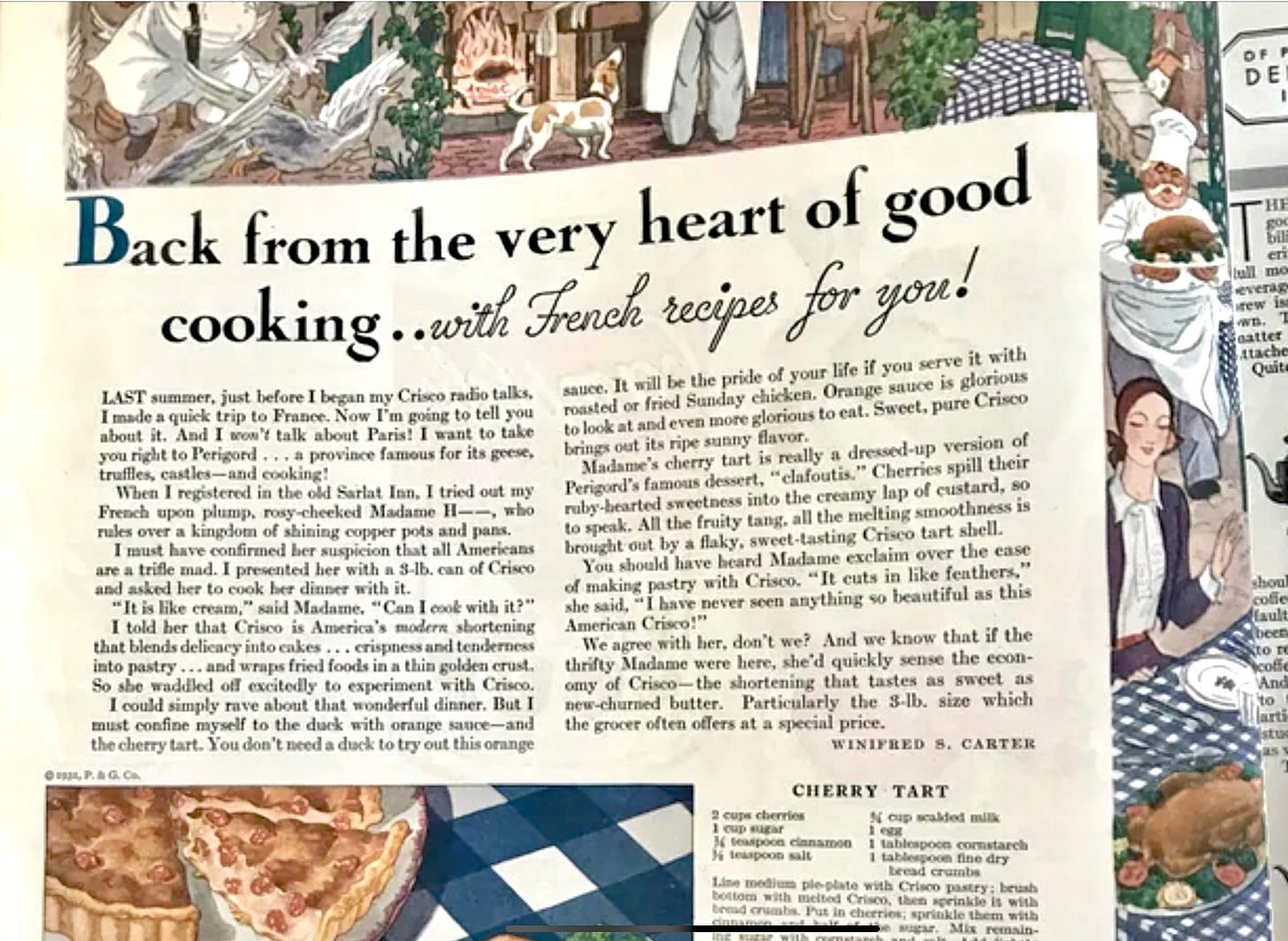
LET’S PLAY A GAME: WHICH INVENTIONS were born 100 years ago? The automatic traffic signal, bulldozer, Q-Tip, self-winding watch, or Snickerdoodle cookie? (And no cheating by asking your friend Google.)
The answer is…all of them.
But the real truth—and bonus points!—is that Snickerdoodles, the cinnamon-topped sugar cookies, have been baked for more than a century.
Cornelia Campbell Bedford, better known as "Nellie," was a New York City cooking teacher and newspaper columnist who had been developing recipes for the Cleveland Baking Powder company. In 1891, her Snickerdoodles recipe, a sugar cookie dough spread into a pan and sprinkled liberally with cinnamon and sugar before baking, went viral. Which at the end of the 19th Century meant the recipe was printed in newspaper columns daily for the next year.
Early Snickerdoodles were just butter cookies. But the quirky name was the appeal. John Mariani says in The Dictionary of American Food & Drink that this nonsense word implied the cookie was quick to make or that it was made from a little of this and a little of that—a pantry cookie.
And where in America it was born is still up for grabs, but the most mentions come from Pennsylvania and the Midwest, wherever there are Mennonite and Amish baking communities. Indiana embraces the Snickerdoodle as its own, and Hoosier poet James Whitcomb Riley is said to have loved them. On his birthday—October 7 —Snickerdoodles are baked at the historic James Whitcomb Riley home in Indianapolis as a remembrance.
Winifred S. Carter enters the room
Procter & Gamble, based in Cincinnati, needed to better reach its customers. In the early 1920s, it hired Eleanor Ahern, a career home economist, to bridge the gap between manufacturing and advertising. She had graduated from the University of Chicago in 1913, taught high school home ec in West Chicago, and had worked as a hospital dietitian. She had the background to oversee P&G’s test kitchen and bring attention to a new shortening made from cottonseed oil, which was being marketed as more digestible than lard and more shelf-stable and affordable than butter. Rabbis were giving it their blessing for Jewish cooks.
But Crisco was getting fierce competition from Spry over at Lever Brothers and Snowdrift made by the Wesson oil people. So Ahern created the persona of Winifred S. Carter, and she and other home economists on her team became the ghost writers of Carter’s recipes, radio shows, and cookbooks. Rival shortening Spry had a similar fictitious Aunt Jenny portrayed by actress Edith Spencer who was her voice on radio and lent her face to photographs as Spry vied to gain market share.
They were simply following the lead of The Washburn-Crosby Company (now General Mills) who birthed Betty Crocker in 1921.
The timing could not have been better. Women in the kitchen were influenced by new but seemingly familiar faces. They dutifully clipped their recipes from local newspapers and sent away for cookbooks created by food manufacturers.
How Crisco became entrenched in American recipes.
For generations before, cakes had been built on butter, sugar, flour, and eggs, but in just a few decades, butter was being removed. Crisco was the shortening leader in the marketplace right into the Depression years, the war years, and by the 1950s and ‘60s, there was a transformation, a whitening and lightening of baked goods that took place in bakeries as well as homes where in places like the Deep South, the can of Crisco resting at the back of the fridge was a jumpstart to making morning biscuits or frying chicken.
The simplest cookie recipe of all—the Snickerdoodle—was no longer crisp and buttery, but instead, soft, white, and pillowy.
In 1923, Crisco marketed "Mrs. T's Snicker Doodles: the favorite recipe of an English-woman" in their newspaper ads. It got the seal of approval from Winifred S. Carter and other culinary experts such as Miss Allen, hired to give recipes their thumbs-up.
The skinny on trans-fats
I know the Crisco texture because I was raised making chocolate chip cookies with Crisco or with half Crisco and half butter. That was the recipe on the back of the Nestle bag.
Crisco was created in 1911 by a process called hydrogenation or adding hydrogen to a liquid oil to make it semi-solid. It was something P&G was already doing to make soap from cottonseed oil. You could spread Crisco like lard or butter to grease cake pans, and if you added it to roll recipes, they became lighter.
Compared to rancid animal fats, yes, Crisco was easier to digest. But we now know that these partially hydrogenated fats, or trans-fats, clog the cardiovascular system. In 2013, the Food and Drug Administration stated partially hydrogenated oils are no longer Generally Recognized as Safe (GRAS) in human food. Manufacturers were asked to remove them.
Crisco was sold to J.M. Smucker in 2002 and to B&G Foods in 2020. Today it contains soybean oil, fully hydrogenated palm oil, and palm oil. The nutritional labeling states no cholesterol and no trans-fat, but in truth, the FDA doesn’t care about fractions of percentages, and Crisco contains less than 1 percent trans-fat but more than 0.
So, getting to the recipe I share today, I let you decide what fat to use. In 100 years since Snickerdoodles were a thing, we not only bake in a new way, but we bake our way.
I call for some Crisco to make the cookies light and fluffy and some butter to give them flavor and crispiness. (In effect, it is a truce, but a delicious one.) But you can go your own way and make them in Winifred’s fashion with all shortening or Nellie’s way with all-butter. Or, try them with coconut oil, a white solid fat.
Is it irony or just human nature that 100 years ago our grandmothers were infatuated with someone who didn’t exist? And that someone convinced them to ditch butter and bake with Crisco instead?
As I was about to hit publish on this post, I came across an obituary for a Laura Ritter Ruttkay of Cincinnati, who died just three years ago. She was born in 1929 and ‘’wore a hat and white gloves to P&G every day to work in the complaint dept as Winifred S. Carter.’’ She was also a bridge champ, Girl Scout leader, excelled at needlework, and helped her husband start his own business. Laura Ruttkay was one of the many faces behind P&G’s Winifred S. Carter…women who changed how we bake.
Marketing a new way of cooking and baking was big business back then, and such dishonesty might not happen today, right? But what about artificial intelligence, tracking ads, and Alexa? Are they, without our knowing, coercing us into changing our cooking and baking habits?
I think I’ll go bake a batch of Snickerdoodles and ponder it all. And if I’m feeling fancy, I’ll use a more intense Ceylon or Saigon cinnamon, because in the beginning, 100 years ago and more, Snickerdoodles were all about the cinnamon, the sugar, and the silly name.
Happy Baking!
- xo, Anne
For Thursday paid subscribers: Open Thread and a Snickerdoodle Cake!
I share the Snickerdoodle Cake recipe above, plus let’s talk kitchen appliances. What are your favorite brands, are you cooking with induction? Do you want to? (We expect our British friends to weigh in on Aga, btw.) What’s the best fridge for the money? What do you love about your current kitchen? What do you hate? You will receive an email from me Thursday morning, and then the conversation starts…
THE RECIPE:
Shirley’s Snickerdoodles
This recipe belonged to Shirley Hutson, the recently departed mother of my friend and recipe tester Martha Bowden. The leavening in this recipe is a combination of cream of tartar and baking soda, an old-school combo that together makes baking powder. It gives Snickerdoodles their characteristic lightness and makes them feel nostalgic. Add a little nutmeg to the topping if you like, and as I mentioned above, use the fat of your choice. For all butter, use two sticks. The cookies will be crispier but less soft and pillowy.
Makes about 4 ½ dozen cookies
Prep: 15 to 20 minutes
Bake: 8 to 10 minutes
For the dough:
1 ½ cups granulated sugar
1/2 cup (4 ounces) lightly salted butter, at room temperature, see Note
½ cup vegetable shortening
1 teaspoon pure vanilla extract
2 large eggs
2 ¾ cups all-purpose flour
2 teaspoons cream of tartar
1 teaspoon baking soda
For the topping:
¼ cup plus 1 tablespoon granulated sugar
2 teaspoons ground cinnamon
1. Place a rack in the upper third of the oven and preheat the oven to 375° F.
2. Make the cookie dough: Place the 1 ½ cups of sugar and the butter and shortening in a large mixing bowl and beat with an electric mixer on medium speed until creamy, about 2 minutes, scraping down the side of the bowl once. Add vanilla and the eggs, one at a time, continuing to beat on medium speed for about 30 seconds.
3. Place the flour, cream of tartar, and baking soda in a bowl and stir with a fork to combine. Add the dry ingredients to the butter mixture and beat on low speed until incorporated, scraping down the side of the bowl as needed.
4. Make the topping: Stir together the ¼ cup plus 1 tablespoon of sugar and the cinnamon in a shallow bowl.
5. Using a teaspoon, scoop the cookie dough into balls about 1 ¼ inches in diameter. The dough will be soft but manageable. Roll the balls of dough in the cinnamon-sugar mixture until evenly coated. Place them on an ungreased baking sheet about 2 inches apart.
6. Bake the cookies until the edges are lightly golden but the centers are still a little soft to the touch, 8 to 10 minutes. Remove the baking sheet from the oven and let the cookies rest on the pan 1 minute. Using a metal spatula, transfer the cookies to wire racks to cool completely. Scrape the baking sheet, then repeat the process with the remaining cookie dough, letting the baking sheet cool first so the dough does not spread too much.
Note: If using unsalted butter, add 1/2 teaspoon salt to the recipe.










Snickerdoodle Cake, count me in 😋
I’m intrigued with the idea of using half butter, half shortening in these cookies. Do you think it would make a difference in the texture to use a shortening other than Crisco, like Earth Balance or Miyoko’s Vegan Butter? I’m not a huge Crisco fan. Thanks! Love this piece!